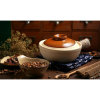Maclura Cochinchinensis an Excellent Remedy for Contusions
The Golden Cinnamon is an essential component in traditional Chinese
medicine, renowned for its unique fragrance and numerous medicinal
properties. It is known for its ability to warm and disperse cold,
activate blood circulation, and resolve blood stasis. As a result, it is
widely used in Chinese herbal formulas to treat symptoms such as
coldness in the spleen and stomach, and menstrual pain. Its aromatic
flavor also makes it a common seasoning in cooking and baking, adding
flavor and fragrance to dishes. Origin:
[Botanical Name]: Golden Cinnamon [English Name]: Maclura
cochinchinensis (Lour.) Corner [Family]: Moraceae [Other Names]:
Taiwanese Hedge, Hong Kong Hedge, Aotou Changzhi, Da Ding Guang, Ci Ge
(Taiwan), Nu Tuo (Shi Yi), Xian Zhi (Jiong Mu). Distribution and Morphology:
[Distribution]: Found in South China, the Philippines, India, Malaysia,
Africa, and Taiwan. [Morphology]: The Golden Cinnamon is an evergreen
dioecious shrub, growing up to 2-4 meters in height. It can be erect or
climbing. The roots have an orange-yellow bark, and the branches are
gray-brown, smooth, and dotted with scattered lenticels, featuring erect
or slightly curved spines, thick and measuring 5-10mm in length. The
leaves are alternate and simple; leaf blades are leathery, inverted
ovate, oval, or elongated oval, measuring 3-9cm in length and 1-2.8cm in
width, with blunt or gradually pointed tips and sometimes with slight
notches at the base. The leaf margins are entire, and both surfaces are
hairless. There are 3 primary veins and 6-9 pairs of secondary veins.
The leaf stalks are 5-10mm long. The inflorescence is globose, single or
in pairs in the axils, with short stalks and covered with soft hairs.
The flowers are unisexual; the male inflorescence has a diameter of
about 1.8cm, and the male flowers have 4 petal-like structures with
thick and hairy tips. The multiple fruits are globose, fleshy,
orange-red when ripe, measuring 3-5cm in diameter, and covered in hairs.
The achenes are enclosed within the fleshy perianth and bracts. It
flowers from April to May and bears fruit from September to October.
Functions and Indications:
The rhizomes of Golden Cinnamon, when decocted and ingested, have
febrifuge and detoxifying properties, making them an excellent remedy
for contusions. The fruit acts as a tonic. The leaves are used to treat
insomnia, while the spines have the function of dispersing blood stasis.
It is primarily used to treat accumulations and obstructions in the
abdomen and lumps. The rhizomes are employed to treat pulmonary
tuberculosis, stomach, and duodenal ulcers. [Source]: Illustrated
Handbook of Commonly Used Medicinal Plants in Taiwan, Volume III.








